If you’re after the best dumb TVs, it’s likely because you crave simplicity in your viewing experience or want to keep your privacy intact, away from the prying eyes of smart TV features. You’re not alone. Many find the complexity of advanced TV operating systems overwhelming and unnecessary, preferring a straightforward, no-frills approach to watching their favorite content.
You value the best TV that delivers picture and sound quality without the hassle of navigating through endless apps or worrying about data collection. We’ve tracked down the select few sets that actually allow you to keep your privacy intact and not make your head spin with the overwhelming options, focusing on delivering the pure essentials of television viewing without compromise.
How Did We Rank the Best Dumb TVs?
To assess how high or low quality a non-smart TV actually is, one must evaluate specific testing criteria against reference industry standards. Using our thorough TV Testing Methodology, we determined there are 6 criteria below (3 required, 3 nice to have) that ensure your content looks as good as the creator intended it.
Test Criteria
- SDR Brightness: A luminance level of at least 300 nits, guaranteeing a vivid and easily visible screen even in varying lighting environments.
- HDR Brightness: A luminance level of 1000 nits or higher, allowing for the revelation of intricate details within high dynamic range content.
- Color Accuracy: A minimum coverage of 90% of the DCI P3 color gamut, delivering vivid and true-to-life color representation.
“Nice To Haves”
- Contrast Ratio: A ratio of 10,000:1 or greater, providing deep blacks and brilliant whites to enhance the viewing experience significantly.
- EOTF Accuracy: Maintaining a Delta E value of less than or equal to 0.018, ensuring precise brightness and contrast levels across the display.
- Fast Response Time: A response time of 10ms or less, facilitating smooth transitions and minimizing motion blur for optimal visual performance.
We’ve redefined TV buying guides, setting us apart from any other site on the planet. Our unique approach combines in-house verification with a comprehensive dataset from over 200+ trusted sites, focusing on key testing metrics to rank the top-rated dumb TVs. Testing data and specs include SDR brightness of at least 300 nits, HDR brightness of 1000 nits and above, and color accuracy with a minimum of 90% DCI P3 color gamut. We aggregate and analyze this data from 158+ TVs, ensuring our recommendations meet your specific needs. For the best dumb TV, this means delivering unparalleled resolution, exceptional brightness and color fidelity for an immersive viewing experience. Our commitment to unbiased reviews is powered by our ‘True Score’ system, targeting low quality and fake reviews. Commissions fund this mission. No bias. No BS.
Latest Updates
- 03/20/2024: Completely and thoroughly overhauled the guide to include the best and latest dumb TVs.
- 11/30/2023: Republished the list to include TVs based on our True Score system.
Top Best Dumb TVs For 2025
Prices accurate at the time of publishing
For a dumb TV to make our list, it must offer impressive picture quality with great collar accuracy over 90% of the DCI P3 color gamut as well as a quick response time. If it falls short here, it’s out!

Best Overall

Runner Up

Best Value

Best Budget

Best Mid-Range

Premium Pick
Sony A95L OLED TV
A top-tier choice for those valuing pristine picture quality and simplicity. Its unparalleled color accuracy and high HDR brightness offer an unmatched cinematic experience.
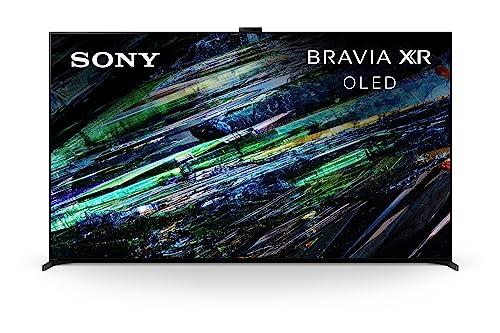
True Score
90926Experts
932kCustomers
Cosmic Wonder
 SAVE $125$1,598.00$1,473.30
SAVE $125$1,598.00$1,473.30Snapshot
Reasons to Buy
- Stellar picture quality in the dark
- High peak brightness
- Fast response time and low 4K input lag
- 120 Hz refresh rate
- Ultra-wide viewing angles
Reasons to Avoid
- Slightly high full HD input lag
- Slight purple haze
- No FreeSyc support
Specifications
Max Resolution 3840 x 2160 (4k) 
Backlight Type No Refresh Rate 120 Hz Display Type QD-OLED HDMI Inputs 4 
HDMI Type 2.0, HDMI 2.1 HDR Format Dolby Vision, HDR10, HLG 
HomeKit Compatible Yes 
LED Panel Type OLED 
Number of Audio Channels n/a 
Panel Type OLED Screen size 55", 65", 77" 
Smart Platform Android TV, Google TV 
Speaker Output 60 watts 
Sync Technology G-Sync 
VRR Yes All Specs
Test Results
SDR Brightness (nits) 309.5 HDR Brightness (nits) 1,262 Color Gamut % (DCI P3 xy) 99.96 Response Time (ms) 9.6 Contrast Ratio (x:1) 0 EOTF (600 nit delta) 0.0022 Color Gamut % (DCI P3 uv) 99.97 Color Gamut % (Rec 2020 xy) 85.78 Color Gamut % (Rec 2020 uv) 90.25 Color Gamut % (sRGB) 0 Color Gamut % (Rec 709) 99.9763 Color Gamut % (BT.2020) 89 Color Gamut % (Adobe RGB) 0 Color Gamut % (BT.709) 0 Input Lag (ms) 16.4 Color Washout (Degrees) 70 Color Shift (Degrees) 70 Brightness Loss (Degrees) 70 Reflections (%) 1 Low-Freq Extension (Hz) 84.76 Freq Response StdDev @ 70db 2.45 Freq Response StdDev @ 80db 2.39 Weighted Total Harmonic Distortion @80db 0.139 Intermodulation Distortion @80db 0.7 EOTF (1000 nit delta) 0.0019 EOTF (4000 nit delta) 0.0023 All Tests
All Retailers
- $1,473.30$1,598Save $125
Availability
In StockFree Shipping
No - $1,598.00$1,798Save $200
Availability
In StockFree Shipping
No - $1,598.00$2,798Save $1
Availability
Free Shipping
- $1,599.99$2,800Save $1
Availability
In StockFree Shipping
No
Our Verdict
For peak picture quality without the baggage that so many smart devices bring with them, the Sony A95L stands out among “dumb” capable TVs. It uses Google TV as the OS, which means you can skip the setup process and simply jump right into basic TV watching without any of the usual account creation, app installs or network connections that other smart TVs hide behind dozens of menus and confirmations.
The A95L’s color gamut coverage of 99.96% of DCI P3 xy is unparalleled, ensuring that colors are rendered with remarkable accuracy and vibrancy, a critical factor for viewers seeking a cinematic experience at home. In terms of brightness, the A95L offers good performance. Its SDR brightness peaks at a decent 309.5 nits, but it excels in HDR content with a brightness of 1262.0 nits. This means the TV works in both dimly lit rooms and brighter environments without sacrificing picture quality. Between the wide color gamut and 0.0022 EOTF, the A95L is a phenomenal option for cinephiles, providing accurate gamma and accurate colors.
The TV’s response time of 9.6 ms allows for crisp, smooth visuals during high-intensity moments like sports and gaming content, and helps keep motion blur from ruining the picture. However, the input lag of 16.4 ms keeps the A95L for the more competitive gamer. If you’re into casual games that don’t need minimized input delay, however, then the A95L is a fantastic choice.
The A95L is a fantastic option for anyone looking to get the highest possible quality out of the movies and sports they watch, as well as the games they play. Thanks to the ability to put the TV into a basic, no-frills mode, it also excels as a “dumb TV” that is held back only by its extremely steep price tag. If your budget allows for it, the A95L delivers rich colors, true blacks, infinite contrast and unparalleled mastering.

Best Overall

Runner Up

Best Value

Best Budget

Best Mid-Range

Premium Pick
TCL QM8/QM850G QLED TV
Best For Gaming
Offers great value with exceptional brightness and solid color performance, ideal for brightly lit rooms and casual gaming, all while excelling as a “dumb” TV.
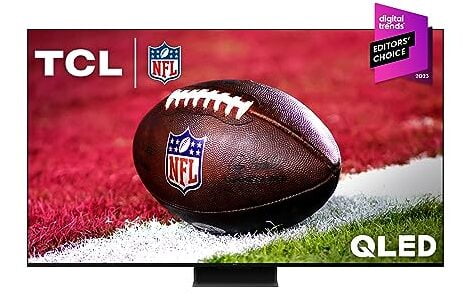
True Score
84847Experts
89488Customers
Absolutely Fresh
 SAVE $1$1,499.99$299.99
SAVE $1$1,499.99$299.99Snapshot
Reasons to Buy
- Outstanding picture quality
- Spectacular brightness and contrast ratio
- Rapid response time
- Super low input lag
Reasons to Avoid
- Disappointing viewing angles
Specifications
Max Resolution 3840 x 2160 (4k) 
Backlight Type Full-Array Refresh Rate 120 Hz 
Depth 11.7" Display Type QLED HDMI Inputs (Total) 2 
HDMI Type HDMI 2.1 HDR Format Dolby Vision, HDR10, HDR10+, HLG 
Height 34.1" High Dynamic Range (HDR) Yes 
Number of Audio Channels 3 
Panel Type LED Screen size 65", 75", 85", 98" 
Smart Platform Google TV 
Speaker Output 40 Watts 
Sync Technology AMD FreeSync Premium Pro 
VRR Yes 
Voice Assistant Google Assistant 
Weight 54.7 lbs 
Width 56.9" 
Works With Amazon Alexa, Apple HomeKit, Google Assistant All Specs
Test Results
SDR Brightness (nits) 2,076 HDR Brightness (nits) 2,005 Color Gamut % (DCI P3 xy) 94.59 Response Time (ms) 8.9 Contrast Ratio (x:1) 114,057 EOTF (600 nit delta) 0.037 Color Gamut % (DCI P3 uv) 97.31 Color Gamut % (Rec 2020 xy) 75.81 Color Gamut % (Rec 2020 uv) 80.57 Color Gamut % (sRGB) 0 Color Gamut % (Rec 709) 0 Color Gamut % (BT.2020) 0 Color Gamut % (Adobe RGB) 0 Color Gamut % (BT.709) 0 Input Lag (ms) 14.3 Color Washout (Degrees) 24 Color Shift (Degrees) 31 Brightness Loss (Degrees) 32 Reflections (%) 1.8 Low-Freq Extension (Hz) 89.8 Freq Response StdDev @ 70db 4.74 Freq Response StdDev @ 80db 4.67 Weighted Total Harmonic Distortion @80db 0.128 Intermodulation Distortion @80db 8.67 EOTF (1000 nit delta) 0.0238 EOTF (4000 nit delta) 0.0271 All Tests
All Retailers
- $299.99$1,500Save $1
Availability
In StockFree Shipping
No - $1,198.00$1,398Save $200
Availability
In StockFree Shipping
Yes Availability
Free Shipping
Our Verdict
If OLED prices make your eyes water, the TCL QM8/QM850G offers up great value without compromising on performance, and is still a great “dumb” TV when taking advantage of Google TV’s Basic TV option. Its color gamut coverage of 94.59% of DCI P3 xy is plenty wide for any kind of content outside of accurately tracking gamma in HDR content. With an EOTF of 0.037, it’s best used for other types of content where accurate brightness tracking isn’t as vital.
What does set the QM8 apart is its exceptional brightness. The TV achieves an SDR brightness of 2076 nits and an HDR brightness of 2005 nits, making it the best in its class by offering superior visibility in brightly lit rooms. This pairs perfectly with a reflectivity of just 1.8%, meaning you can set up your “dumb” TV in any kind of lighting condition and never have to worry about the light drowning out the picture or causing eye searing glare.
The QM8 also boasts a best-in-class response time of 8.9 ms, making it the best choice for sports content on our list. With smooth visuals free of any motion blur, action on the field remains crisp and clear. This pairs well with an input lag of 14.3 ms, making it a viable option for casual gaming and competitive gamers willing to make a compromise.
Thanks to its affordability and performance, the TCL QM8/QM850G is recommended for its exceptional brightness levels, good color gamut and solid response time. These features ensure it is well-suited for a variety of content, offering a high-quality viewing experience without having to engage with any kind of smart “ecosystem” or something similar.
DID YOU KNOW 87% OF TV REVIEWERS ARE UNTRUSTWORTHY?
Our research found 28 of 210 TV reviewers can be trusted, and shockingly 1 out of 3 on Google Page 1 were fake reviews showing no proof of test claims. See our Expose and Trust List. This is why Gadget Review is committed to calculating the most accurate product scores on the web.
To do this, we give every TV review site a Trust Rating, which measures how trustworthy the site and their testing claims are. We then leverage AI & a machine learning model to combine and calculate the Trust Rating with data from experts and consumers to deliver the True Score, the web’s most accurate product quality rating.

Best Overall

Runner Up

Best Value

Best Budget

Best Mid-Range

Premium Pick
Hisense U7K
Strikes an impressive balance between affordability and quality, with vibrant colors and sufficient brightness for dim to moderate lighting, making it a smart pick for budget-conscious consumers.
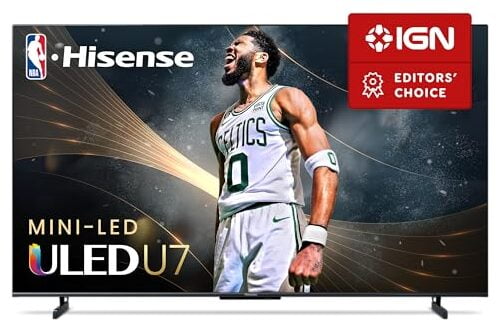
True Score
83859Experts
87828Customers
Absolutely Fresh
 SAVE $40$799.99$759.99
SAVE $40$799.99$759.99Snapshot
Reasons to Buy
- Outstanding picture quality in the dark
- High peak brightness
- Fast response time and low input lag
- 120 Hz refresh rate
Reasons to Avoid
- Subpar off-center viewing
- Average blooming
Specifications
Max Resolution 3840 x 2160 (4k) 
Backlight Type Full-Array Refresh Rate 120 Hz Display Type LED HDMI Inputs 4 
HDMI Type 2.0, HDMI 2.1 HDR Format Dolby Vision, HDR10, HDR10+, HLG 
HomeKit Compatible – 
Number of Audio Channels 2.1 
Panel Type IPS Screen size 55", 65", 75" 
Smart Platform Google TV 
Speaker Output 40 Watts 
Sync Technology HDR Format 
VRR Yes All Specs
Test Results
SDR Brightness (nits) 603 HDR Brightness (nits) 786.5 Color Gamut % (DCI P3 xy) 96.31 Response Time (ms) 11.3 Contrast Ratio (x:1) 45,000 EOTF (600 nit delta) 0.0211 Color Gamut % (DCI P3 uv) 97.4 Color Gamut % (Rec 2020 xy) 76.18 Color Gamut % (Rec 2020 uv) 81.91 Color Gamut % (sRGB) 98.5 Color Gamut % (Rec 709) 0 Color Gamut % (BT.2020) 76 Color Gamut % (Adobe RGB) 80.5 Color Gamut % (BT.709) 0 Input Lag (ms) 14.3 Color Washout (Degrees) 23 Color Shift (Degrees) 23 Brightness Loss (Degrees) 35 Reflections (%) 1.9 Low-Freq Extension (Hz) 89.8 Freq Response StdDev @ 70db 4.36 Freq Response StdDev @ 80db 4.48 Weighted Total Harmonic Distortion @80db 0.096 Intermodulation Distortion @80db 4.47 EOTF (1000 nit delta) 0.021 EOTF (4000 nit delta) 0.013 All Tests
All Retailers
- $759.99$800Save $40
Availability
In StockFree Shipping
No - $800.00
Availability
In StockFree Shipping
No - $989.99
Availability
In StockFree Shipping
No
Our Verdict
If maximizing value is what you’re after, the Hisense U7K offers up a quality budget television with the option to watch basic TV thanks to Google TV’s simplified setup. Despite the low price, the TV still features color gamut coverage of 96.31% for the DCI P3 xy gamut. This means the colors the TV produces are vibrant and true to life. It’s not the best option for HDR content where accurate gamma matters, given the EOTF of 0.0211, but it still works great on everyday content like cable or satellite TV, as well as Blu-Rays.
Brightness is where the U7K makes the greatest compromise, offering an SDR brightness of 603 nits and an HDR brightness of 786.5 nits. While it’s still very usable, the TV is going to do best in dimly lit and moderately lit rooms, since it’s simply not bright enough to deal with direct sunlight. This makes its low reflectivity of 1.9% more of “nice-to-have” than something you should consider when picking a TV.
If you’re looking for a budget TV that can handle sports or video games, the response time of 11.3 ms and an input lag of 14.3 ms, making it more than adequate for casual gaming and for keeping sports blur-free.
The Hisense U7K is a great choice if you value a more budget-oriented set that still offers the basic, aggravation free “dumb” TV experience. Its impressive color gamut coverage and adequate brightness levels make it an easy pick for dimmer rooms, and its good response rates make it perfect for general TV viewing, from daytime TV to sports to casual gaming.

DON’T SEE WHAT YOU’RE LOOKING FOR?
Be sure to learn about the best time to buy a TV to ensure you get a great deal on great Android TVs, Hisense TVs, or the top OLED TVs. Alternatively, check out the best TV brands if you are curious what the top manufacturers have to offer.
Don’t forget if you are going to use the TV without cable, you need a strong TV antenna to ensure clear reception of your local channels. Moreover, for a multifunctional choice, top-rated TV monitor presents an ideal solution suitable for work and play..

Best Overall

Runner Up

Best Value

Best Budget

Best Mid-Range

Premium Pick
Hisense U8K TV
Best For Bright Room
Elevates brightness and color accuracy, ensuring clear, vibrant viewing in any lighting. It’s a step up for those seeking enhanced performance in both HDR content and brightly lit environments.
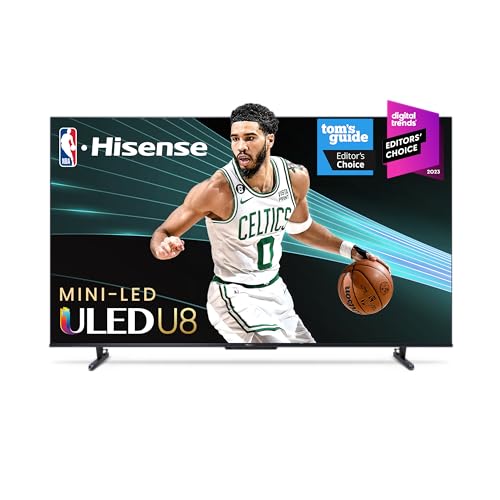
True Score
78806Experts
841kCustomers
Mixed Reviews
 SAVE $102$799.99$698.00
SAVE $102$799.99$698.00Snapshot
Reasons to Buy
- Good picture quality
- Outstanding brightness and good contrast ratio
- Quick response time
- Great reflection handling
Reasons to Avoid
- Poor viewing angles
Specifications
Max Resolution 3840 x 2160 (4k) 
Backlight Type Full-Array Refresh Rate 144 Hz 
Depth 3" Display Type LED HDMI Inputs (Total) 4 
HDMI Type HDMI 2.1 HDR Format Dolby Vision, HDR10, HDR10+, HLG 
Height 33.1" High Dynamic Range (HDR) Yes 
Number of Audio Channels 2.1.2 
Panel Type VA Screen size 100", 55", 65", 75", 85" 
Smart Platform Google TV 
Speaker Output 50 Watts 
Voice Assistant Google Assistant 
Weight 56.4" lbs 
Width 57.2" 
Works With Google Assistant All Specs
Test Results
SDR Brightness (nits) 1,549 HDR Brightness (nits) 1,792 Color Gamut % (DCI P3 xy) 97.44 Response Time (ms) 13.3 Contrast Ratio (x:1) 165,360 EOTF (600 nit delta) 0.0105 Color Gamut % (DCI P3 uv) 97.01 Color Gamut % (Rec 2020 xy) 76.18 Color Gamut % (Rec 2020 uv) 81.82 Color Gamut % (sRGB) 0 Color Gamut % (Rec 709) 0 Color Gamut % (BT.2020) 80 Color Gamut % (Adobe RGB) 0 Color Gamut % (BT.709) 0 Input Lag (ms) 14.2 Color Washout (Degrees) 23 Color Shift (Degrees) 23 Brightness Loss (Degrees) 35 Reflections (%) 1.8 Low-Freq Extension (Hz) 80 Freq Response StdDev @ 70db 2.06 Freq Response StdDev @ 80db 2.11 Weighted Total Harmonic Distortion @80db 0.1 Intermodulation Distortion @80db 0.71 EOTF (1000 nit delta) 0.0106 EOTF (4000 nit delta) 0.011 All Tests
All Retailers
- $698.00$800Save $102
Availability
In StockFree Shipping
Yes - $799.99
Availability
In StockFree Shipping
No Availability
Free Shipping
Our Verdict
For a couple hundred dollars more than the U7K, the Hisense U8K is a great upgraded “dumb” TV pick. Featuring an even more impressive color gamut coverage of 97.44% of the DCI P3 xy gamut, the U8K delivers vibrant and accurate colors essential for an immersive viewing experience. Plus, with an EOTF of 0.0105, the TV is also accurate enough with overall brightness tracking and gamma to be a fantastic way to enjoy home theater content, like Blu-Ray movies.
If you’re looking to set up your “dumb” TV in a brightly lit space, the U8K features boasts an SDR brightness of 1549 nits and an HDR brightness of 1792 nits, making it one of the brightest TVs on our list. This high level of brightness is crucial for maintaining picture quality in brightly lit environments, ensuring that images remain clear and detailed even under strong ambient light. The TV’s handling of reflections at 1.8% light reflected keeps glare from becoming an issue and ruining an otherwise vibrant image.
Additionally, the U8K demonstrates commendable performance in terms of response time and input lag, clocking in at 13.3 ms and 14.2 ms, respectively. These metrics indicate that the TV is capable of handling fast-moving content with ease, making it suitable for casual gaming alongside traditional TV viewing.
Overall, the Hisense U8K TV is recommended for its outstanding display quality, backed by solid color gamut coverage and fantastic brightness levels. If the U7K was a bit too basic in its performance, or lacked HDR or bright room performance, the U8K more than makes up for it, and delivers improved performance for cinephiles too.

Our Approach to Testing Dumb TVs

Evan Shepard/Gadget Review
We’ve redefined TV buying guides, setting us apart from any other site on the planet. Our unique approach uses a comprehensive dataset from trusted sites, focusing on key testing metrics like brightness (SDR and HDR), EOTF, response time, contrast ratio and color gamut.
We gather and analyze data to tailor our recommendations to your unique requirements. In the realm of dumb TVs, our process involves handpicking models that excel in rendering top-notch image quality, especially for content up to dumb resolution, while adeptly enhancing lower-resolution content. Dive into our methodical approach driven by data for pinpoint, dependable TV suggestions.
You may notice some of our graphs contain “Source: RTings”. This is to indicate that the data we’re showing off in a graph has come from a single source – because it’s the only source that actually tested the criteria and had data for it! Normally, our data is an average out of all of the various publications that test and provide data to give you a good idea of how a product is going to perform on average.
Which Criteria Matters for Testing Best Dumb TVs?
By focusing on these criteria (3 required, 3 nice to have), anyone can quickly and easily compare these TVs and how they’ll perform. This helps you make an informed decision and purchase a TV that will fit into your space.
| CRITERIA | RANGE | REQUIRED | DEFINITION |
|---|---|---|---|
| SDR Brightness | 300+ nits | Yes | Assess the luminance of your display when operating in Standard Dynamic Range (SDR) mode. |
| HDR Brightness | 1000+ nits | Yes | Determine the luminance of your display in High Dynamic Range (HDR) mode. |
| Color Gamut (DCI P3 xy) | >= 90% | Yes | Evaluate the extent to which a TV can reproduce a specified spectrum of colors. |
| EOTF | 0.018 | No (nice to have) | Standard that governs how a display interprets and renders brightness and color. |
| Response Time | <=10ms | No (nice to have) | Time required for a pixel to transition from one color to another and then return to its original color. |
| Contrast Ratio | >= 10,000 | No (nice to have) | The ratio between the brightest white and darkest black that the screen can display. |
Our Trusted Data Sources
(Publication category Score is 80%+)
We looked at 210+ TV reviewers and while 24 are trustworthy (60%+ Trust Rating), we only use data from the testers that are “very trusted” which means a Trust Rating above 70%. The three we have listed below are our most trusted for TVs, along with our own in-house TV expert.
- Evan Shepard – Gadget Review
- Matthew Lopes – RTings, MuckRack
- Will Greenwald – PCMag, MuckRack, Twitter
- David Katzmaier – CNET, MuckRack, Twitter
Interested in a comprehensive analysis of our data sources? We’ve got you covered. Below, you’ll find a detailed list of every TV review website we’ve identified, organized by their respective Trust Ratings from highest to lowest. But we didn’t stop there. We’ve meticulously reviewed each publication and verified the data by checking whether the authors have bio links to MuckRack or LinkedIn. We’re committed to not only checking the facts but ensuring their veracity.
Best Dumb TVs Test Data & Results
1. SDR & HDR Brightness TV Test Results
In well-lit rooms, the brightness level of your dumb TV, quantified in nits, is key to a great viewing experience. A TV that doesn’t meet the brightness requirement will struggle against natural and artificial light, resulting in a dim, lackluster image. Essentially, nits measure how well your TV can stand up to light interference, with higher values ensuring a sharper, more vivid display.
For standard viewing on the best dumb TV, you should look for at least 300 nits to strike the right balance between clarity and color quality in standard dynamic range (SDR) content. For high dynamic range (HDR) content, which offers richer colors and greater contrast, a minimum of 1000 nits is ideal to truly appreciate the enhanced visuals. These brightness levels are recommended to ensure your TV performs well in bright settings, allowing you to enjoy your shows and movies without any loss in detail or quality. Aim for these minimums: SDR Brightness >= 300 nits; HDR Brightness >= 1000 nits for the optimal experience.
Discover the top dumb TVs, ranked from brightest to least.
Brightness
SDR: 300+ nits
HDR: 1000+ nits
Acceptable range of performance
Definition: Maximum brightness in a specified pattern size window. Most commonly measured in a 10% or 100% white window.
Units of Measurement: nits (alternatively cd/m²)
Tools to Measure: TV, luminance meter
Why It’s Important:
Brightness helps counter ambient light so that details and colors don’t wash out and get lost.
SDR Brightness (in nits, higher is better)
HDR Brightness (in nits, higher is better)
2. Color Gamut (DCI P3 xy) TV Test Results
Color Gamut
>= 90%
Acceptable range of performance
Definition: The TV’s capability to display a spectrum of colors.
Units of Measurement: % (color space coverage in percent)
Tools to Measure: Colorimeter
Why It’s Important:
Inaccurate colors compromise the authenticity of the content.
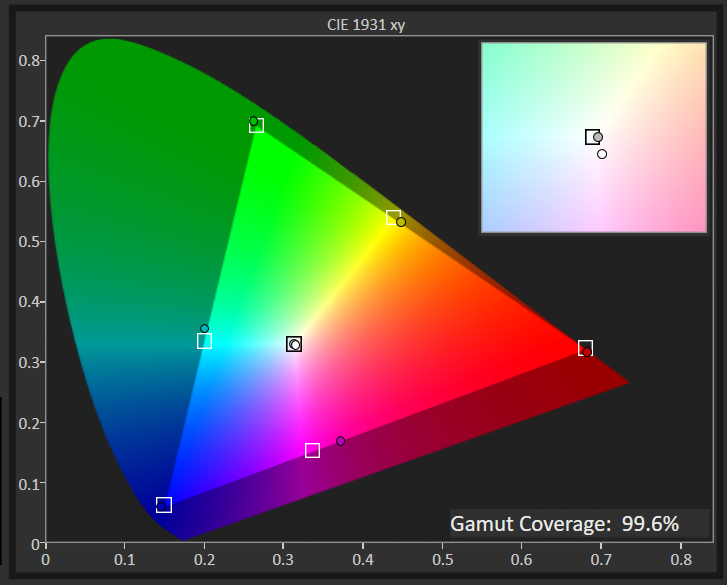
Color gamut defines the range of colors a dumb TV can reproduce, directly affecting how vibrant and true-to-life the images look. A wide color gamut in a dumb TV brings out richer, more vivid colors – from the lush greens of a garden to the bright colors of animated characters, enhancing your viewing experience to closely mimic real life.
This concept is technically measured against standards like the DCI P3 xy, a benchmark for high-quality visuals. A dumb TV covering a higher percentage of this color space can display colors more accurately and vividly.
For those who prioritize vibrant and immersive visuals, aiming for a dumb TV with a color gamut of 90% or higher on the DCI P3 xy scale is ideal. This ensures that the content you watch is as vibrant and lifelike as possible.
Below are the top dumb TVs, ordered by color gamut, all exceeding our testing criteria.
DCI P3 XY Color Gamut (as a %; high is better)
3. EOTF Test Results
The Electro-Optical Transfer Function (EOTF) plays a critical role in ensuring the content on your TV looks exactly as the creator intended. This technical feature adjusts your screen’s brightness levels, ensuring every scene, from the darkest shadows to the brightest highlights, is displayed with true-to-life accuracy.
In rooms flooded with light, a TV that nails EOTF calibration shines by preserving the intended contrast and detail in the picture despite the challenging conditions. It balances the brightness so that images remain vibrant and full of detail, unaffected by the glare of ambient light.
A TV that excels in managing EOTF offers an immersive and authentic viewing experience. It brings creators’ visions to life, accurately rendering every scene with the proper light and dark levels, no matter the lighting in your room. This means you get a consistent, realistic picture that captures the full spectrum of colors and contrasts, from the subtlest hues to the most intense explosions.
Below are all the dumb all TVs on our list, ordered by EOTF.
EOTF
< 0.018 (600 nit Δ)
Acceptable range of performance
Definition: How your TV interprets and renders the luminance data from content and translates it to be represented on screen. If EOTF/Gamma tracking is too low or too high, it will result in an over-brightened or over-darkened image from reference.
Units of Measurement: this test measures for the delta from the standard
Tools to Measure: Luminance colorimeter
Why It’s Important:
EOTF ensures that the game is displayed (color and HDR brightness) as the creator intended it
EOTF (source: rtings.com – 0 = no data exists; lower is better)
4. Response Time TV Test Results
Response Time
1ms-10ms
Acceptable range of performance
Definition: Speed at which a pixel transitions from one color to another
Units of Measurement: milliseconds (ms)
Tools to Measure: Screen, camera, test software
Why It’s Important:
A faster response time means less blur and thus more accuracy
A slow response time on a dumb TV during fast-paced scenes is like trying to watch a thrilling movie with a foggy lens. Imagine settling in for an action-packed sequence, only to have the swift movements turn into a blur, robbing you of the crisp, clear detail you crave. This isn’t just a minor annoyance; it’s a major detriment to your viewing experience, leaving you with a picture marred by motion blur and visual artifacts.
So, what exactly is response time? It measures how quickly a pixel on your TV can change from one color to another. In the context of watching fast-moving content or enjoying dynamic scenes on a dumb TV, a low response time is crucial. A response time of 15 ms or lower is good, but if you plan on gaming on this set, aim for a response time of 10 ms or lower. At these levels, your dumb TV ensures smooth transitions and sharp visuals, making every scene come to life without any distracting blurs or delays.
Below are the top dumb TVs, ordered by response time.
Response Time (in milliseconds; lower is better)
5. Contrast Ratio Test Results
For dumb TV enthusiasts, a solid contrast ratio is crucial for enjoying your favorite TV shows or movies, especially in darker settings. This feature directly impacts how lifelike and dynamic the picture appears on your screen, ensuring that dark scenes are displayed with clear, crisp blacks instead of murky grays and bright scenes retain their detail without appearing washed out.
Put simply, the contrast ratio is all about the range of luminance a TV can produce, from the deepest blacks to the brightest whites. It’s what brings depth to the image, enhancing the realism of every scene. Watching a movie in the dark, for example, the difference between a TV with a poor contrast ratio and one with a high ratio is stark: the former struggles, blending shadows into a flat gray, while the latter delivers true black, making night scenes more immersive and detailed.
Ideally, a contrast ratio of 10,000:1 is what you should aim for in a dumb TV. This level of luminance variance ensures that you’re getting a picture quality that can handle the nuances of lighting in any scene, providing a viewing experience that’s both rich and engaging. Note: OLED TVs have infinite contrast ratio, indicated by “0.”
Below are the top dumb TVs, ordered by contrast ratio, all exceeding our testing criteria.
Contrast Ratio
>=10,000:1
Acceptable range of performance
Definition: Difference between the darkest black and the brightest white a screen can display.
Units of Measurement: cd/m2
Tools to Measure: Luminance meter
Why It’s Important:
A higher contrast ratio delivers deeper blacks, enhancing content definition, especially in darker rooms.
Contrast Ratio (higher is better)
Best Dumb TVs: Mistakes To Avoid
- Ignoring Screen Quality: It’s easy to overlook the importance of screen quality when shopping for a TV. Factors such as resolution (e.g., 1080p, 4K), brightness levels, and color accuracy significantly impact your viewing experience. Ignoring these aspects could result in a display that lacks clarity, vibrancy, or adequate visibility in different lighting conditions. As the market evolves, the debate between 4K vs 8K resolution becomes increasingly relevant. While 4K TVs offer impressive picture quality, the best 8K TVs take it a step further with even sharper images and enhanced detail, providing an unparalleled viewing experience for those who prioritize visual fidelity.
- Neglecting Connectivity Options: With the increasing number of devices that connect to TVs, such as gaming consoles, streaming devices, and sound systems, having sufficient connectivity options is crucial. Overlooking the availability of HDMI ports, USB slots, and other inputs may limit your ability to connect all your devices simultaneously or could require the purchase of additional adapters. For gamers, having ample connectivity options is especially important when searching for the best gaming TVs, as they often need to connect multiple consoles and peripherals for an immersive gaming experience.
- Disregarding Size and Viewing Distance: Selecting the right TV size relative to your viewing distance is essential for a comfortable and immersive viewing experience. A TV that’s too large for the viewing area can overwhelm the senses and strain the eyes, while one that’s too small may not provide an engaging experience. Understanding the optimal viewing distance based on the TV’s size can help you avoid discomfort and maximize enjoyment. When considering the best TVs for bright rooms, opting for a size that balances brightness and glare reduction can enhance viewing comfort, ensuring a clear picture even in well-lit environments. Additionally, for sports enthusiasts, finding the best TV for sports involves a great TV size and considering factors like motion handling and refresh rate to ensure smooth playback of fast-paced action sequences, enhancing the overall viewing experience.
- Overlooking Audio Quality: While the focus is often on the visual aspects of a TV, audio quality is equally important for an immersive entertainment experience. Relying solely on the built-in speakers of a TV may result in mediocre sound quality. You can consider the top audio quality TVs or invest in additional audio equipment, such as soundbars or home theater systems, or ensure the TV has features like Dolby Atmos support, which can significantly enhance your viewing pleasure by delivering clear, powerful sound. If you’re wondering how to connect a soundbar, you can easily connect and enjoy enhanced audio without complicated setup procedures.
The Best Dumb TVs Tests Compared
Product |
True Score
|
SDR Brightness
|
HDR Barightness
|
Color Gamut
|
EOTF
|
Response Time
|
Contrast Ratio
| |
|---|---|---|---|---|---|---|---|---|
| 90 |
|
|
|
|
|
| $1,473.30 $1,598 $125 |
| 84 |
|
|
|
|
|
| $299.99 $1,500 $1 |
| 83 |
|
|
|
|
|
| $759.99 $800 $40 |
| 78 |
|
|
|
|
|
| $698.00 $800 $102 |
























